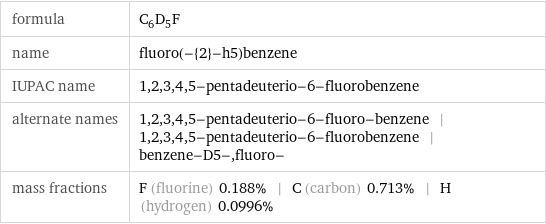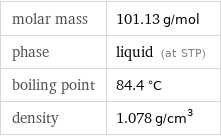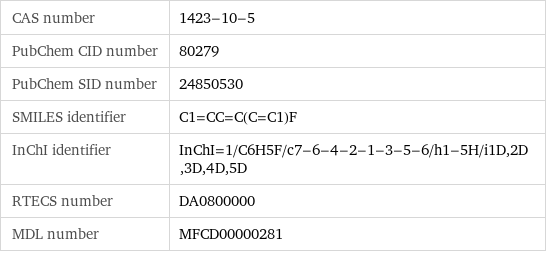Input interpretation

fluoro(-{2}-h5)benzene
Chemical names and formulas

formula | C_6D_5F name | fluoro(-{2}-h5)benzene IUPAC name | 1, 2, 3, 4, 5-pentadeuterio-6-fluorobenzene alternate names | 1, 2, 3, 4, 5-pentadeuterio-6-fluoro-benzene | 1, 2, 3, 4, 5-pentadeuterio-6-fluorobenzene | benzene-D5-, fluoro- mass fractions | F (fluorine) 0.188% | C (carbon) 0.713% | H (hydrogen) 0.0996%
Lewis structure

Draw the Lewis structure of fluoro(-{2}-h5)benzene. Start by drawing the overall structure of the molecule, ignoring potential double and triple bonds: Count the total valence electrons of the carbon (n_C, val = 4), fluorine (n_F, val = 7), and hydrogen (n_H, val = 1) atoms: 6 n_C, val + n_F, val + 5 n_H, val = 36 Calculate the number of electrons needed to completely fill the valence shells for carbon (n_C, full = 8), fluorine (n_F, full = 8), and hydrogen (n_H, full = 2): 6 n_C, full + n_F, full + 5 n_H, full = 66 Subtracting these two numbers shows that 66 - 36 = 30 bonding electrons are needed. Each bond has two electrons, so in addition to the 12 bonds already present in the diagram add 3 bonds. To minimize formal charge carbon wants 4 bonds. Identify the atoms that want additional bonds and the number of electrons remaining on each atom: Fill in the 3 bonds by pairing electrons between adjacent highlighted atoms. Note that the six atom ring is aromatic, so that the single and double bonds may be rearranged: Answer: | |
3D structure

3D structure
Basic properties

molar mass | 101.13 g/mol phase | liquid (at STP) boiling point | 84.4 °C density | 1.078 g/cm^3
Units

Liquid properties (at STP)

density | 1.078 g/cm^3 refractive index | 1.465
Units

Non-standard atom properties

H-2 | 5
Chemical identifiers

CAS number | 1423-10-5 PubChem CID number | 80279 PubChem SID number | 24850530 SMILES identifier | C1=CC=C(C=C1)F InChI identifier | InChI=1/C6H5F/c7-6-4-2-1-3-5-6/h1-5H/i1D, 2D, 3D, 4D, 5D RTECS number | DA0800000 MDL number | MFCD00000281
NFPA label

NFPA label

NFPA health rating | 1 NFPA fire rating | 4 NFPA reactivity rating | 0
Safety properties

flash point | -12.78 °C

DOT hazard class | 3 DOT numbers | 2387